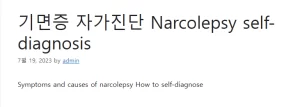Symptoms and causes of narcolepsy How to self-diagnose
Symptoms and causes of narcolepsy How to self-diagnose
Narcolepsy is a rare disease that affects about 2 per 100,000 people. 기면증 자가진단
As much as it is a disease that is difficult to find around, the media and people around them, as well as the person concerned, tend to think of themselves as just lazy people. 좋은뉴스
There are times when you feel drowsy despite getting enough sleep. Most of these symptoms are caused by chronic fatigue, but if you suddenly fall asleep or become excessively sleepy, you should suspect narcolepsy. We have summarized the symptoms and causes of narcolepsy and how to self-diagnose them.

index
narcolepsy symptoms
narcolepsy causes
How to self-diagnose narcolepsy
narcolepsy symptoms
Symptoms of narcolepsy include narcolepsy, cataplexy, paralysis, hypnagogic hallucinations, etc. Among them, narcolepsy is a symptom in which excessive sleep is poured during the day and falls asleep unknowingly, and wakes up with a clear mind, but sleepy symptoms return an hour or two later no see.
In addition, the main symptoms are sudden emotional changes, cataplexy, muscle weakness, paralysis, and hypnagogic hallucinations that seem like vivid dreams when waking up or falling asleep.
Narcolepsy is known as a rare intractable disease that is difficult to cure, but it is a disease that requires steady management as it can help you maintain your daily life normally if you combine medication and behavioral therapy.
narcolepsy causes
The cause of narcolepsy has been found to be a problem caused by a decrease in the secretion of hypocretin, a hormone that maintains wakefulness in the brain, but the exact reason for the decrease is not known.
The rate of incidence in men and women is similar, and it is common between the ages of 10 and 20. Because of the strong genetic factor, if there is a patient suffering from narcolepsy in the family, the incidence rate is 40 times higher than that of the general population.
How to self-diagnose narcolepsy
– I often fall asleep at any time and place.
– Usually, the process and time to fall asleep is very fast.
– Drowsiness often comes after waking up after a good night’s sleep.
– I tend to sleep at least 8-10 hours a day.
– Experiencing problems such as frequent awakenings, nightmares, and scissors during sleep.
If 4 or more of the above apply, you are suspected of narcolepsy and it is recommended that you visit a nearby hospital or consult online.